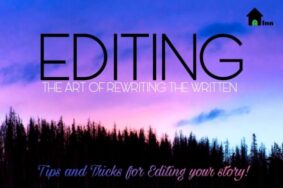Hello Artoons,
Seeing a few comments about editing stories one has written, I thought I’d share my newly acquired experiences with you.
One thing to remember is that every writer is different. There are no standard procedures for writing and editing which will suit every writer. Each writer has to find a way that will help them the most. As with me, when I started writing, I only wrote without paying much attention to editing. The tenses jumped. The paragraphs were long. The dialogues got mixed up. Somehow, I managed to sustain the required word count.
This article will mostly focus on adhering to the word count while maintaining the essence of the story.
There is a famous phrase- “Don’t check the word count while writing. Edit later.”
Though true, it has a very tricky variable. We should know what to remove and what to retain so that the story remains the same. That is not easy.
1. Plan in advance
Even if you are a pantser, you will have a rough idea of your storyline as you write. At that point, take a pause or sit, stand, walk and plan. Register the word limit in your mind. Start weaving the threads of the story in your mind or on paper. Count the number of acts you are likely to get. Then, calculate the size of every act. You don’t need a scientific calculator. An act usually is around 350-600 words depending on the action involved. This would give you a rough idea of how many words you will have in the story. The count could go for a run once you start writing, but fear not. Why? Because you know what you want. Once you start editing, you will notice that there are sentences that are not needed.
This method, of course, needs practice, but which one doesn’t?
Start writing for a word count. Make sure the story doesn’t cross more than 125% of the final word count. That is, if the upper limit is 1000 words, the first draft should not bemore than 1200-1250 words. It is always easy to remove 250 words than 400 or 700. The more words we need to eliminate, the higher the risk of cutting out the important or connecting parts. It could ruin the story altogether. Now, start working on the draft with 1250 words.
The first round of edit is to remove the sentences that repeat the information given. The second round is to check for sentences that do not contribute to the story.
The above two steps will reduce the word count to 1100 or less.
2. Sometime in February, I shared a story which was within the word count and edited according to the previous two points. The readers couldn’t understand the ending. My standard reply was that I could not fit my story into the limit despite editing.
There was a lady (I’m grateful to her forever) who gave me the most valuable advice- Rewrite the sentences.
She took around 20 sentences from my story and rephrased each one. She gave me the word counts (for each sentence) before and after editing.
I saved almost 35 words. Those would have enough to give the story a decent ending. Until then, I never concentrated on the sentences individually. It did not occur to me. Once I started focusing on them, I realized that the final story was a lot better than the original.
- Break longer sentences.
- Combine shorter sentences and remove the pronouns.
- Truncate the sentences when using the first person narrative style.
- Try to use Deep POV whenever possible.
- If the action occurs in multiple lines, rewrite.
“She sat on a chair. The chair was near the fireplace. It was her favorite spot.” (16 words)
“The fireplace was her favorite spot. She sat on a chair near it.” (13 words)
“She sat on a chair near the fireplace which was her favorite spot.” (13 words)
“She sat on a chair near the fireplace, her favorite spot.” (11 words)
What if you still have extra words?
Focus on the keywords. Do you need to mention the chair? If yes, go to the next sentence. If not, remove it.
“She sat near her favorite spot, the fireplace.” (8 words)
How will you know if the chair was needed or not?
The previous or the next paragraphs will tell you.
Example: “The police found her body on a chair near the fireplace. The heat prevented them from determining the time of her death.”
or
“It took an effort to rise from the chair. Her arthritis was troubling her again.”
Statements like the above ones will give the readers the required information to understand the story. Excluding “the chair” from the initial statement will not harm the story.
Combine both the above points (1 &2) and we have a story that gets as close to the required word count as possible. One final edit will place the story within the limit. Itwill be easy because we would have read the story a few times.
Writing and editing are continuous learning experiences that teach us something new every time. Typos somehow manage to slip our eagle eyes and greet the readers. One way to handle typos is to take a break from your work and read it after a gap. Don’t fret if you still notice a typo or two in the final copy. I read somewhere that our eyes read what our mind wants.
You might find some in this article too. My proofreader didn’t do a good job.
Keep writing. Keep editing.








